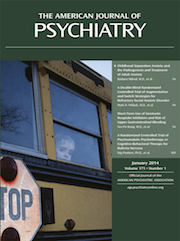High Dosages of Antidepressants Prescribed Without Risk?
To the Editor: In the June issue of the Journal, Zivin et al. (1) examined whether high-dosage citalopram or sertraline would increase the risk of ventricular arrhythmia or mortality. Their study, tapping a large database, found decreased risk associated with high-dosage antidepressants, contradicting Food and Drug Administration (FDA) warnings of greater risk of QT interval prolongation and torsade de pointes with high-dosage citalopram. Several issues regarding that study warrant attention.
When physicians’ choice of antidepressant dosage is affected by risk of poor prognosis, confounding by indication may occur (2) and lead to results suggesting that high dosages of antidepressants are safe. Even before the FDA warning, low dosages of antidepressants were commonly prescribed for frail or elderly patients, who are more likely to develop adverse outcomes. Thus, the decreased or absent risk associated with a high-dosage prescription may result from a failure to consider various important unmeasured confounders (e.g., increased cardiac output) and mediators (e.g., smoking cessation) in a healthier study population. This bias can worsen when a measurement of person-time is used, because combining the number of persons and the duration of their time in the study may increase the diversity of interactions, allowing the impact of omitted variables to become more pervasive in regression analysis. Taken together, if the risk for different dosage groups is not assessed with equipoise, the results cannot substitute for results obtained from the crossover study submitted to the FDA.
The Zivin et al. study has other methodological problems. The authors collapsed categories of a comorbidity index into one continuous covariate, altering magnitudes of comorbidity and increasing the possibility of data misinterpretation (3). Their study does not address whether particularly elevated risk exists in individuals with specific comorbid illnesses (e.g., heart failure)—those individuals targeted in the FDA warning. In addition, the person-time measure used by the authors permits more than one observation for the same individual during periods when different dosages were prescribed. In this situation, the possible group effects generated between different individuals and within the same individual in regression analyses should be examined; otherwise, the precision of regression estimates is compromised. Finally, contrary to the FDA warning, the authors concluded that no increase in risk of ventricular arrhythmia was associated with high-dosage citalopram treatment without providing the theoretical explanation for their finding. Their results suggested that high-dosage antidepressants decreased the risk, although they avoided coming to that conclusion. Further study is needed to unravel the biological mechanisms underlying that finding.
1 : Evaluation of the FDA warning against prescribing Citalopram at doses exceeding 40 mg. Am J Psychiatry 2013; 170:642–650Link, Google Scholar
2 : Confounding by indication: an example of variation in the use of epidemiologic terminology. Am J Epidemiol 1999; 149:981–983Crossref, Medline, Google Scholar
3 : Potential misinterpretations caused by collapsing upper categories of comorbidity indices: an illustration from a cohort of older breast cancer survivors. Clin Epidemiol 2009; 1:93–100, Crossref, Medline, Google Scholar



